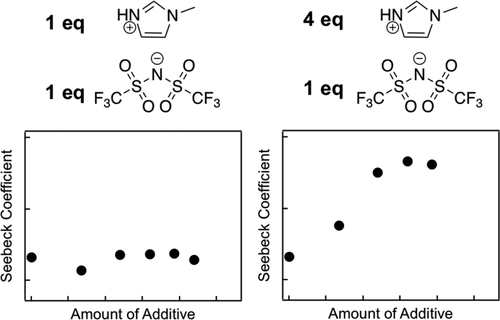当前位置:
X-MOL 学术
›
Chem. Mater.
›
论文详情
Our official English website, www.x-mol.net, welcomes your
feedback! (Note: you will need to create a separate account there.)
Tailoring the Seebeck Coefficient of PEDOT:PSS by Controlling Ion Stoichiometry in Ionic Liquid Additives
Chemistry of Materials ( IF 7.2 ) Pub Date : 2018-07-11 00:00:00 , DOI: 10.1021/acs.chemmater.8b02114 Amir Mazaheripour 1 , Shubhaditya Majumdar 2 , Dakota Hanemann-Rawlings 2 , Elayne M. Thomas 1 , Christine McGuiness 3 , Lauriane d’Alencon 4 , Michael L. Chabinyc 1 , Rachel A. Segalman 1, 2
Chemistry of Materials ( IF 7.2 ) Pub Date : 2018-07-11 00:00:00 , DOI: 10.1021/acs.chemmater.8b02114 Amir Mazaheripour 1 , Shubhaditya Majumdar 2 , Dakota Hanemann-Rawlings 2 , Elayne M. Thomas 1 , Christine McGuiness 3 , Lauriane d’Alencon 4 , Michael L. Chabinyc 1 , Rachel A. Segalman 1, 2
Affiliation

|
Mixing simple additives into poly(3,4-ethylenedioxythiophene)/poly(styrenesulfonate) (PEDOT:PSS) dispersions can greatly enhance the thermoelectric properties of the cast films with little manufacturing cost, but design rules for many of these additives have yet to emerge. We show that controlling stoichiometry in ionic liquid (I.L.) additives can decouple morphological and electronic modifications to PEDOT:PSS and enhance its power factor by over 2 orders of magnitude. Blending I.L. additives with a 1:1 stoichiometry between cationic imidazolium (Im+) derivatives and anionic bis(trifluoromethane)sulfonamide (TFSI–) groups into PEDOT:PSS dispersions raised the film conductivity to ∼1000 S/cm. The Seebeck coefficient, which gives insight into the electronic structure as well as thermoelectric performance, remained unchanged. This behavior mimics that of popular high-boiling solvent additives such as dimethyl sulfoxide and ethylene glycol, which restructure the film morphology to enhance carrier mobility. Blending I.L. additives with a 4:1 stoichiometry between Im+ and TFSI– groups raises the conductivity in a similar manner but also enhances the Seebeck coefficient. This selective Seebeck enhancement proceeds from the interaction of excess Im+ with anionic poly(styrenesulfonate) (PSS–) groups, similar to previous studies using inorganic salts, that results in a shift in charge carrier populations. Inorganic salts by themselves cannot raise the conductivity of PEDOT:PSS to appropriate values since they lack the solvent restructuring effect. These I.L. additives combine the effects of high-boiling solvents and diffuse ions, with the ability to tailor the Seebeck coefficient through ion stoichiometry.
中文翻译:

通过控制离子液体添加剂中的离子化学计量来调整PEDOT:PSS的塞贝克系数
将简单的添加剂混合到聚(3,4-乙撑二氧噻吩)/聚(苯乙烯磺酸盐)(PEDOT:PSS)分散液中可以大大提高流延膜的热电性能,而制造成本却很少,但是许多此类添加剂的设计规则尚未出现。我们表明,控制离子液体(IL)添加剂的化学计量可以将PEDOT:PSS的形态学和电子修饰解耦,并将其功率因数提高2个数量级以上。在阳离子咪唑鎓(Im +)衍生物和阴离子双(三氟甲烷)磺酰胺(TFSI –)分成PEDOT:PSS分散体,将薄膜电导率提高到〜1000 S / cm。Seebeck系数保持不变,它可以洞悉电子结构以及热电性能。这种行为模仿了流行的高沸点溶剂添加剂(例如二甲基亚砜和乙二醇)的行为,它们可以改变膜的形态以增强载流子迁移率。共混IL添加剂与4:IM之间1化学计量+和TFSI -基团引发类似的方式的导电性,但也增强了Seebeck系数。选择性Seebeck增强来自过量的Im +与阴离子聚苯乙烯磺酸盐(PSS –)基团,与以前使用无机盐的研究相似,导致电荷载流子数量的变化。无机盐本身不能将PEDOT:PSS的电导率提高到适当的值,因为它们缺乏溶剂重组作用。这些IL添加剂结合了高沸点溶剂和弥散离子的作用,并具有通过离子化学计量法调整塞贝克系数的能力。
更新日期:2018-07-11
中文翻译:

通过控制离子液体添加剂中的离子化学计量来调整PEDOT:PSS的塞贝克系数
将简单的添加剂混合到聚(3,4-乙撑二氧噻吩)/聚(苯乙烯磺酸盐)(PEDOT:PSS)分散液中可以大大提高流延膜的热电性能,而制造成本却很少,但是许多此类添加剂的设计规则尚未出现。我们表明,控制离子液体(IL)添加剂的化学计量可以将PEDOT:PSS的形态学和电子修饰解耦,并将其功率因数提高2个数量级以上。在阳离子咪唑鎓(Im +)衍生物和阴离子双(三氟甲烷)磺酰胺(TFSI –)分成PEDOT:PSS分散体,将薄膜电导率提高到〜1000 S / cm。Seebeck系数保持不变,它可以洞悉电子结构以及热电性能。这种行为模仿了流行的高沸点溶剂添加剂(例如二甲基亚砜和乙二醇)的行为,它们可以改变膜的形态以增强载流子迁移率。共混IL添加剂与4:IM之间1化学计量+和TFSI -基团引发类似的方式的导电性,但也增强了Seebeck系数。选择性Seebeck增强来自过量的Im +与阴离子聚苯乙烯磺酸盐(PSS –)基团,与以前使用无机盐的研究相似,导致电荷载流子数量的变化。无机盐本身不能将PEDOT:PSS的电导率提高到适当的值,因为它们缺乏溶剂重组作用。这些IL添加剂结合了高沸点溶剂和弥散离子的作用,并具有通过离子化学计量法调整塞贝克系数的能力。











































 京公网安备 11010802027423号
京公网安备 11010802027423号